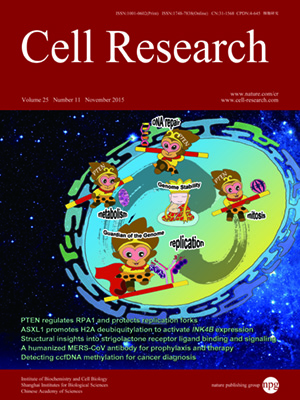
Volume 25, No 11, Nov 2015
ISSN: 1001-0602
EISSN: 1748-7838 2018
impact factor 17.848*
(Clarivate Analytics, 2019)
Volume 25 Issue 11, November 2015: 1269-1272 | Open Access
LETTERS TO THE EDITOR
Direct conversion of astrocytes into neuronal cells by drug cocktail
Lin Cheng1,4,*, Longfei Gao1,*, Wuqiang Guan2, Jianxin Mao1, Wenxiang Hu1, Binlong Qiu1, Jian Zhao1, Yongchun Yu2 and Gang Pei1,3
1State Key Laboratory of Cell Biology, Institute of Biochemistry and Cell Biology, Shanghai Institutes for Biological Sciences, Chinese Academy of Sciences, Shanghai 200031, China
2State Key Laboratory of Medical Neurobiology, Shanghai Medical College and Institutes of Brain Science, Fudan University, Shanghai 200032, China
3Collaborative Innovation Center for Brain Science, School of Life Science and Technology, Tongji University, Shanghai 200092, China
4State Key Laboratory of Medical Genomics, Shanghai Institute of Hematology, Rui Jin Hospital, Shanghai Jiao Tong University School of Medicine, Shanghai 200025, China
Correspondence: Gang Pei,(gpei@sibs.ac.cn)
Neurological disorder is one of the greatest threats to public health according to the World Health Organization. Because neurons have little or no regenerative capacity, conventional therapies for neurological disorders yielded poor outcomes. While the introduction of exogenous neural stem cells or neurons holds promise, many challenges still need to be tackled, including cell resource, delivery strategy, cell integration and cell maturation. Reprogramming of fibroblasts into induced pluripotent stem cells or directly into desirable neuronal cells by transcription factors (TFs) or small molecules can solve some problems, but other issues remain to be addressed, including safety, conversion efficiency and epigenetic memory1,2.
10.1038/cr.2015.120
FULL TEXT | PDF
Browse 2192


